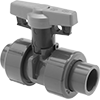Filter by
Body Material
For Use With
Fitting Connection
Handle Type
Ball Material
Maximum Pressure @ Temperature
Valve Function
Valve Type
End-to-End Length
Maximum Temperature
Valve Operation
Diverting Valve Flow Pattern
DFARS Specialty Metals
About On/Off Valves
More







































































